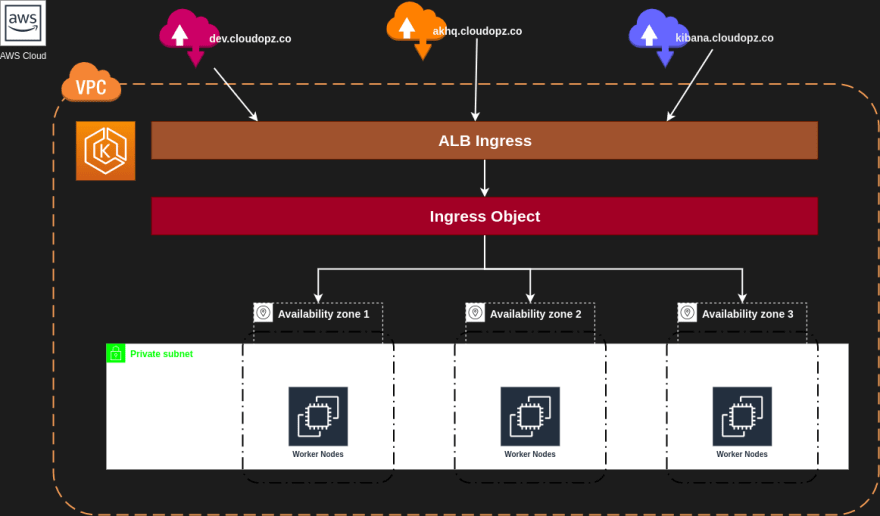28
Create AWS Load Balancer Controller Ingress With CDK8S
- An AWS Application Load Balancer (ALB) when you create a Kubernetes Ingress.
- An AWS Network Load Balancer (NLB) when you create a Kubernetes Service of type LoadBalancer.
Pre-requiste: EKS cluster
In order for the Ingress resource to work, the cluster must have an ingress controller running. Unlike other types of controllers which run as part of the kube-controller-manager binary, Ingress controllers are not started automatically with a cluster.
Using hlem to install
[ec2-user@eks-ctl dist]$ helm repo add eks https://aws.github.io/eks-charts
"eks" has been added to your repositories
export VPC_ID=$(aws eks describe-cluster --name eks-dev --query "cluster.resourcesVpcConfig.vpcId" --output text --region ap-northeast-2)
[ec2-user@eks-ctl dist]$ helm repo list
NAME URL
eks https://aws.github.io/eks-charts
[ec2-user@eks-ctl dist]$ helm repo update
Hang tight while we grab the latest from your chart repositories...
...Successfully got an update from the "eks" chart repository
Update Complete. ⎈Happy Helming!⎈
helm upgrade -i aws-load-balancer-controller \
eks/aws-load-balancer-controller \
-n kube-system \
--set clusterName=eks-dev \
--set serviceAccount.create=false \
--set serviceAccount.name=aws-load-balancer-controller \
--set image.tag="${LBC_VERSION}" \
--set region=ap-northeast-2 \
--set vpcId=${VPC_ID}
Release "aws-load-balancer-controller" does not exist. Installing it now.
NAME: aws-load-balancer-controller
LAST DEPLOYED: Sun Jun 6 10:44:19 2021
NAMESPACE: kube-system
STATUS: deployed
REVISION: 1
TEST SUITE: None
NOTES:
AWS Load Balancer controller installed!
[ec2-user@eks-ctl dist]$ kubectl get deployment -n kube-system aws-load-balancer-controller
NAME READY UP-TO-DATE AVAILABLE AGE
aws-load-balancer-controller 0/2 2 0 8s
[ec2-user@eks-ctl dist]$ kubectl get po -n kube-system
NAME READY STATUS RESTARTS AGE
aws-load-balancer-controller-85847bc9bd-fjdwf 1/1 Running 0 20s
aws-load-balancer-controller-85847bc9bd-gsctk 1/1 Running 0 20sPre-requisite: EKS cluster with OpenID connect, IAM identity provider (Ref to Using IAM Service Account Instead Of Instance Profile For EKS Pods for how to)
First create the IAM role which is federated by IAM identiy provider and assumed by sts:AssumeRoleWithWebIdentity, then attach policy to provide proper permission for the role. Brief of CDK code in python3:
-
iam_oicis the stack of creating IAM identity provider which is used OIDC as provider,open_id_connect_provider_arnis its ARN attribute from the stack. - Policy is created from iam_policy.json
from constructs import Construct
from aws_cdk.aws_s3_assets import Asset
from aws_cdk import (
App, Stack, CfnJson,
aws_iam as iam
)
import re, os
class IamOICProvider(Stack):
def __init__(f, scope: Construct, construct_id: str, eks_cluster, env, **kwargs) -> None:
super().__init__(scope, construct_id, env=env, **kwargs)
oidc_url = eks_cluster.cluster_open_id_connect_issuer_url
iam_oic = iam.OpenIdConnectProvider(
f, construct_id,
url=oidc_url,
client_ids=['sts.amazonaws.com']
)
oidc_arn = iam_oic.open_id_connect_provider_arn
oidc_provider = re.sub("https://", "", oidc_url)
def string_like(name_space, sa_name):
string_like = CfnJson(
f, f'JsonCondition{sa_name}',
value={
f'{oidc_provider}:sub': f'system:serviceaccount:{name_space}:{sa_name}',
f'{oidc_provider}:aud': 'sts.amazonaws.com'
}
)
return string_like
alb_controller_role = iam.Role(
f, 'AlbControllerRole',
role_name='eks-aws-load-balancer-controller-sa',
assumed_by=iam.FederatedPrincipal(
federated=f'{iam_oic.open_id_connect_provider_arn}',
conditions={'StringEquals': string_like('kube-system', 'aws-load-balancer-controller')},
assume_role_action='sts:AssumeRoleWithWebIdentity'
)
)
alb_controller_role.add_managed_policy(
iam.ManagedPolicy.from_managed_policy_name(f, "EksAWSLoadBalancerController",
managed_policy_name='EksAWSLoadBalancerController')
)
alb_controller_role.add_managed_policy(
iam.ManagedPolicy.from_managed_policy_name(f, "EksAWSLoadBalancerControllerAdditional",
managed_policy_name='EksAWSLoadBalancerControllerAdditional')
)$ kubectl annotate serviceaccount -n kube-system aws-load-balancer-controller eks.amazonaws.com/role-arn=arn:aws:iam::123456789012:role/eks-aws-load-balancer-controller-saTrust relationships to ensure correct OIDC url and Condition
{
"Version": "2012-10-17",
"Statement": [
{
"Effect": "Allow",
"Principal": {
"Federated": "arn:aws:iam::123456789012:oidc-provider/oidc.eks.ap-northeast-2.amazonaws.com/id/<OIDC_PROVIDER_ID>"
},
"Action": "sts:AssumeRoleWithWebIdentity",
"Condition": {
"StringEquals": {
"oidc.eks.ap-northeast-2.amazonaws.com/id/<OIDC_PROVIDER_ID>:sub": "system:serviceaccount:kube-system:aws-load-balancer-controller",
"oidc.eks.ap-northeast-2.amazonaws.com/id/<OIDC_PROVIDER_ID>:aud": "sts.amazonaws.com"
}
}
}
]
}[ec2-user@eks-ctl ~]$ kubectl describe sa -n kube-system aws-load-balancer-controller
Name: aws-load-balancer-controller
Namespace: kube-system
Labels: app.kubernetes.io/component=controller
app.kubernetes.io/name=aws-load-balancer-controller
Annotations: eks.amazonaws.com/role-arn: arn:aws:iam::123456789012:role/eks-aws-load-balancer-controller-sa
kubectl.kubernetes.io/last-applied-configuration:
{"apiVersion":"v1","kind":"ServiceAccount","metadata":{"annotations":{"eks.amazonaws.com/role-arn":"arn:aws:iam::123456789012:role/eks...
Image pull secrets: <none>
Mountable secrets: aws-load-balancer-controller-token-gjsc2
Tokens: aws-load-balancer-controller-token-gjsc2
Events: <none>host conditions[ec2-user@eks-ctl ~]$ kubectl get ingress -A
NAMESPACE NAME CLASS HOSTS ADDRESS PORTS AGE
argocd argocd <none> argocd.cloudopz.co k8s-dev-06fc49d1xx-1234567890.ap-northeast-2.elb.amazonaws.com 80 14d
dev app <none> * k8s-dev-06fc49d1xx-1234567890.ap-northeast-2.elb.amazonaws.com 80 18d
dev backend <none> * k8s-dev-06fc49d1xx-1234567890.ap-northeast-2.elb.amazonaws.com 80 8d
dev frontend <none> * k8s-dev-06fc49d1xx-1234567890.ap-northeast-2.elb.amazonaws.com 80 8d
dev dev-alb <none> * k8s-dev-06fc49d1xx-1234567890.ap-northeast-2.elb.amazonaws.com 80 18d
grafana grafana <none> grafana.cloudopz.co k8s-dev-06fc49d1xx-1234567890.ap-northeast-2.elb.amazonaws.com 80 7d3h
logging kibana <none> kibana.cloudopz.co k8s-dev-06fc49d1xx-1234567890.ap-northeast-2.elb.amazonaws.com 80 25hkubectl logs -f --tail=100 -n kube-system -l app.kubernetes.io/name=aws-load-balancer-controllerlookup function and base on the tag the AWS ALB controller created ingress.k8s.aws/stack: <group>
import re
import os
from constructs import Construct
import boto3
from aws_cdk import (
App, Stack, Environment, Tags, CfnTag, Duration,
aws_elasticloadbalancingv2 as elbv2,
aws_route53 as _route53,
)
class Route53Stack(Stack):
def __init__(self, scope: Construct, id: str, env, **kwargs) -> None:
super().__init__(scope, id, env=env, **kwargs)
def cname_record(record_name, hosted_zone):
_route53.CnameRecord(
self, 'Route53Cname',
domain_name=alb_dns,
record_name=record_name,
zone=hosted_zone,
ttl=Duration.minutes(1)
)
alb = elbv2.ApplicationLoadBalancer.from_lookup(
self, "AlbIngress",
load_balancer_tags={'ingress.k8s.aws/stack': 'dev'}
)
alb_dns = alb.load_balancer_dns_name
dev_hosted_zone = 'Z88PZ8J8P8RXXX'
hz = _route53.HostedZone.from_hosted_zone_attributes(
self, id="HostedZone", hosted_zone_id=dev_hosted_zone, zone_name='cloudopz.co')
records = ['dev.cloudopz.co', 'akhq.cloudopz.co', 'argocd.cloudopz.co',
'grafana.cloudopz.co', 'kibana.cloudopz.co']
for record in records:
cname_record(record, hz)28



